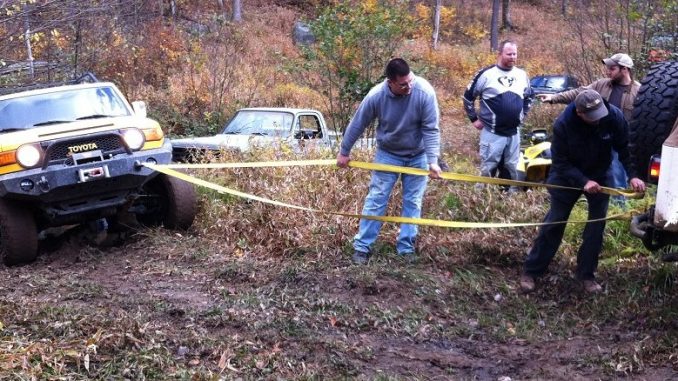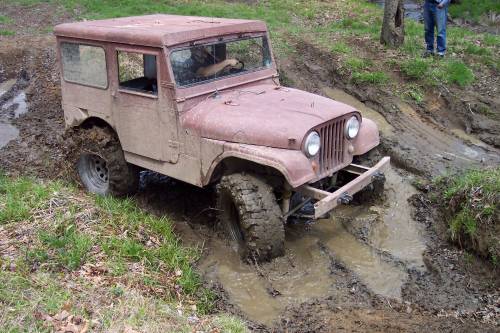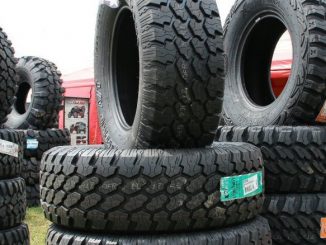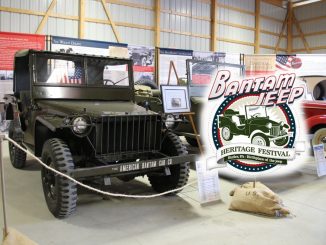
As truck ownership has increased in America, so has the amount of off-highway recreation. There is no special license required to drive off-road, even though there are many different techniques and practices involved. There does exist an often unspoken etiquette that is practiced by old-school four-wheelers, which developed not just so that everyone can get along on the trail, but, primarily, for safety considerations. With the availability of trail-ready 4×4’s, both in the traditional truck mold and outside of it, the slow and steady progression of four-wheeling initiation through involvement and camaraderie has been bypassed. The honor-by-association process misses the chance to be taught to the enthusiastic guy who just bought his first real 4×4.
Responsible 4-wheeling is about finesse. Other features and driving techniques assist in the overall safety of your off-road outing, but finesse is the first and most important portion of your driving repertoire to acquire. Here are some hints to help you out in this area.

- It’s important always to drive within your ability. There are times when in soft sand, like beaches and washes, speed needs to be moderate and flotation through mud and snow needs to be kept up, hence “within your ability.” Usually taking your time on the trail will allow you to pick a smooth path and allow you time to react to the varieties of terrain you can encounter like moving rocks and logs under the tires. If you have a ground clearance deficiency, going slow helps here, in that, if you do hit a rock with the differential or other rock grabber, it will usually stop the vehicle on impact or you will lightly scrape over it. If you were going too fast and hit a rock or other obstacle, it could knock a hole in the oil pan, differential, or even knock off the oil filter.
- Avoid surprises by surveying the road ahead before you encounter it. Make sure the trail goes beyond the obstacle, doesn’t become a bottomless quagmire, has no back side to the hill (cliff?) or just plain ends. You can get a good idea where to place your tires and the differentials to have a plan of approach. And follow through to beyond the obstacle.
- Driving diagonally = Rollover. Always drive straight down hills or steep terrain. Know your approach and departure angles, the bumper to tire distance. Some trails will require off-camber driving. In situations like this it’s best to go slow, keeping the tires in the tracks. Make every attempt to avoid losing attention and ascending up a rock or stump on the up side of the hill. Trucks will tend to slide sideways before rolling over – the tires will slip sideways a little. Stop if the slide puts you off the edge of the track. If it is clear downhill and a rollover is imminent, immediately turn the vehicle into the slide and drive it down. If that is not an option, and you are going over, turn the vehicle off and hold on to your seat-bottom while hoping that the seat belt works properly.
- Reducing tire pressure will increase traction on gravel and sand. For most 4-wheeling purposes, a tire pressure of 18 to 20psi will be adequate. Highway pressure is another consideration altogether. The tire is marked on the side, i.e., 50psi at 3300 pounds. In essence, that one tire could hold my Defender up. Depending on the weight of the loaded vehicle and the size of tire, a tire pressure of between 28 and 35psi works in most on-highway applications. Never overlook the importance of reading the manufacturer’s label. The air pressure difference between the front and rear is due to the tire and auto manufacturers’ experimentation for over/under steer and load variances.
- Cross ditches or logs at an angle so that one wheel at a time goes over the obstacle; the other three help the one wheel to climb over. Dropping the tire into a ditch or crack in a rock can put you and your truck in a vulnerable position. Sometimes the vehicle pitches and one or more tires will catch air. Be very deliberate and careful when approaching this challenging section of any trail. Logs can bounce up and catch the undercarriage, so come off these obstacles slowly and carefully. Turn the vehicle at an angle to facilitate the one tire at a time approach. Be careful not to allow one of the front tires and one of the rear tires to get in the ditch at the same time.

One of the most crucial aspects to off-roading is understanding the absolute importance of tire pressure. Among the most pertinent tire pressure considerations in regards to summer off-roading is utilizing optimum sand tire pressure. Optimum sand tire pressure is a combination of many things, of which truck-owner’s myths are least productive. However, your tires, their construction methods and materials, what your car weighs, how it is loaded, and wheel width, all play into the sand-pressure tire formula with predictable results. Why low pressure works, and how to determine your best sand pressure, follows:
It’s a simple fact, which some diehard truckers still deny, the bigger the footprint, the softer the stuff you can travel in. Boiled down, it’s nothing more than a fact of nature. For those who say skinny, hard tires are better for snow, mud or whatever, please tell me why they don’t use ten-speed bicycle-type tires on snowmobiles? Sand rail people and mud boggers know big feet work better as well. With that out of the way, let’s take a look at tire pressure and footprints.
The choice of tread pattern, otherwise known as your tire’s footprint, is extremely important to consider during your new tire decision making process, and especially so if your are fitting your truck for an off-road adventure. Tread pattern should be chosen based on the intended use of your truck. The most popular tread pattern for all around off-road use is a mud terrain pattern.
The mud terrain or mud tire pattern is characterized by large lugs on the tire with big voids between these lugs. The large lugs provide plenty of bite in low traction conditions while the big voids allow the tire to clean itself by throwing off mud or other material when spinning, thus providing a good bite on every rotation of the tire. These tires are also very popular for rock crawling as the large lugs can provide a way of gripping and pulling the tires up and over irregular rocky edges where a smoother pattern would just spin. The biggest disadvantage of these patterns is that they run rough and loud on the highway. To reduce this problem; choose a tire with irregular or asymmetric spacing of the lugs and voids to reduce harmonic vibration at highway speeds. There are also situations such as light powdery snow or sand where an all-terrain pattern would be better.
The general purpose all terrain tire generally has an interlocked tread pattern with siping (small cuts) on the tread blocks. The voids in these tires are usually much smaller than those on tires designed for use in the mud. The more dense pattern of blocks and smaller voids make these tires more quiet on the street. It also increases the surface area of the tread which gives the tire improved flotation on surfaces such as light powdery snow or sand. The increased siping can be important in snow were it is the number of edges, even quite small edges, biting into the snow that provides the traction. The downside is that the smaller voids cannot clean themselves as easily of packed mud or slush. If these voids fill up with mud the tire loses much of its bite and traction is lost.

A variety of manufacturers also offer a family of tires sometimes called trail tires or some similar name. These are most often tires designed for use on light trucks or sport utility vehicles which see most of their use on the street. They will generally be quieter, get better gas mileage and last longer than either of the other off-road patterns. The tread patterns are designed to provide significantly improved comfort or performance on the street which can sometimes compromise off-road capability. Fortunately this is the limit to which most of their intended market are likely to take them.
——————–
About the Author
Jeff Jackson is a successful free lance writer and truck enthusiast who enjoys providing valuable tips and advice for online purchasers of Truck Accessories, Lift Kits, and Tonneau Covers. When he is not writing he can usually be found in his 4×4 out on the trails of his home state, Florida.




My husband and I are taking our jeep off roading for the first time with some friends, but we are wanting to be a little prepared for whatever might come our way. I like how you pointed out that we need to avoid surprises by paying attention to the road ahead. This will be smart for us to remember so that he will know where to place the tires, and if there are any obstacles ahead.